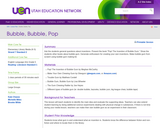
This resource is a poster of the functions of the 3 branches of government.
- Subject:
- Social Studies
- Material Type:
- Reading
- Provider:
- USA.gov
- Author:
- USA Gov
- Date Added:
- 02/20/2017

This resource is a poster of the functions of the 3 branches of government.

This parent guide supports parents in helping their child at home with the 5th grade ELA content. Within the folder you will access Parent Guide PDFs in FIVE Languages: Arabic, English, Hindi, Spanish, and Vietnamese to help on-going communication with caregivers.

This resource contains activities to help students draw conclusions/make inferences. Such activities include: guess the emotion, you are what you bring, using pictures, and links to additional resources.

In this lesson, students analyze the ways in which Draper creates the first-person narrator of Melody and the effects these choices have on the story and the reader. Melody has cerebral palsy; instead of asking students to research about the condition before reading, this lesson invites students to learn about it through the narrator herself in the context of her story. Students meet to discuss the narrator at several pre-determined discussion points and eventually write a brief analysis of the narration.

In this lesson, students will learn how to answer questions by inferring. This lesson is on pages 25-28 and is part of the Asking Questions unit.

In this lesson, students read about Paul Revere's famous ride to warn Americans about the advancement of the British soldiers. Students utilize reading skills to respond to questions about the text and demonstrate understanding.

This lesson is for Grades 4 - 5 on literacy. At Home Learning Lessons are a partnership between the North Carolina Department of Public Instruction, PBS North Carolina, and the William and Ida Friday Institute for Educational Innovation. Each lesson contains a video instructional lesson, a PDF lesson plan with a transcript, and a PDF file of extension activities.

This lesson is for Grades 4 - 5 on literacy. At Home Learning Lessons are a partnership between the North Carolina Department of Public Instruction, PBS North Carolina, and the William and Ida Friday Institute for Educational Innovation. Each lesson contains a video instructional lesson, a PDF lesson plan with a transcript, and a PDF file of extension activities.

This lesson will teach how characters evolve across a story, and that often times the important changes are subtle. This lesson uses accountable-talk during a read aloud of One Green Apple by Eve Bunting to demonstrate how, as readers, students can use the traits of their character as a lens through which to interpret deeper, more significant changes stirring within. They will ultimately use those observations about their characters to author an epilogue for their books. The epilogue will allow students to demonstrate what they have learned about their main character, and it will allow the teacher to assess how well the students understand their characters and the changes their characters experienced across the text.

Tradition in the Lakota Sioux involves giving a name to a child based on his actions, so a young child who moves slowly in all he does earns the name ‘Slow’ from his family. After demonstrating bravery and determination during battle he then earns a new name, Sitting Bull, and this same man later becomes the respected chief of the Lakota Sioux. In this CCSS lesson students will explore Sitting Bull's life through text dependent questions, academic vocabulary, and writing assignments.

In this lesson, students identify the main idea and evaluate the supporting ideas.

This resource, Character Perspective Charting, is an instructional method designed to reflect the actual complexity of many stories and is a practical instructional alternative to story mapping. This strategy delineates the multiple points of view, goals, and intentions of different characters within the same story. By engaging in Character Perspective Charting, students can better understand, interpret, and appreciate the stories they read.

A strong plot is a basic requirement of any narrative. Students are sometimes confused, however, by the difference between a series of events that happen in a story and the plot elements, or the events that are significant to the story. In this lesson, students select a topic for a personal narrative and then do the prewriting in comic-strip format to reinforce the plot structure. Finally, they write their own original narratives based on the comic strip prewriting activity, keeping the elements of narrative writing in mind. This lesson uses a version of "The Three Little Pigs" fairy tale to demonstrate the literary element; however, any picture book with a strong plot would work for this lesson.

Students will read two different texts (an excerpt from Moondial by Helen Cresswell and Through the Looking Glass by Lewis Carroll) and compare them. Questions are provided for each passage.

In this lesson, students learn of Davy Crocket who becomes an American Hero by saving the Earth. Students utilize reading skills to respond to questions about the text and demonstrate understanding.

In this lesson, students use comprehension skills to discuss and respond to questions about a text.

Students will use literary elements to show similarities and differences of today's society to the past. Using the book, Belle Prater's Boy by Ruth White students will be able to compare and contrast the characters Gypsies and Woodrows dilemmas in life to situations taking place in the home, society, and school today.

As a way to support teachers with English Language Arts (ELA) instruction during the pandemic, the NCDPI ELA team created choice boards featuring standards-aligned ELA activities.The intended purpose of these choice boards is to provide a way for students to continue standards-based learning while schools are closed. Each activity can be adapted and modified to be completed with or without the use of digital tools. Many activities can also be repeated with different texts. These standards-based activities are meant to be a low-stress approach to reinforcing and enriching the skills learned during the 2019-2020 school year. The choice boards are to be used flexibly by teachers, parents, and students in order to meet the unique needs of each learner.Exploration activities are provided for a more self-directed or guided approach to independent learning for students. These activities and sites should be used as a way to explore concepts, topics, skills, and social and emotional competencies that interest the learner.

In this lesson, students will look behind the story at the historical, social, and cultural circumstances that shape the narrative throughout Esperanza Rising. The lesson also invites students to contemplate some of the changes Esperanza undergoes as she grows into a responsible young woman and the contradictions that she experiences.

In this lesson, The Jolly Postman is used as an authentic example to discuss letter writing as a genre. Students explore letters to the storybook characters delivered by The Jolly Postman. They then learn how to categorize their own examples of mail. The Jolly Postman uses well-known storybook characters, from fairy tales and nursery rhymes, as recipients of letters. This children's storybook is therefore ideal for using as a review of these genres of literature and as a means of helping children begin to explore rhyme and a variety of writing styles. Several pieces of literature appropriate for use with this lesson are suggested.